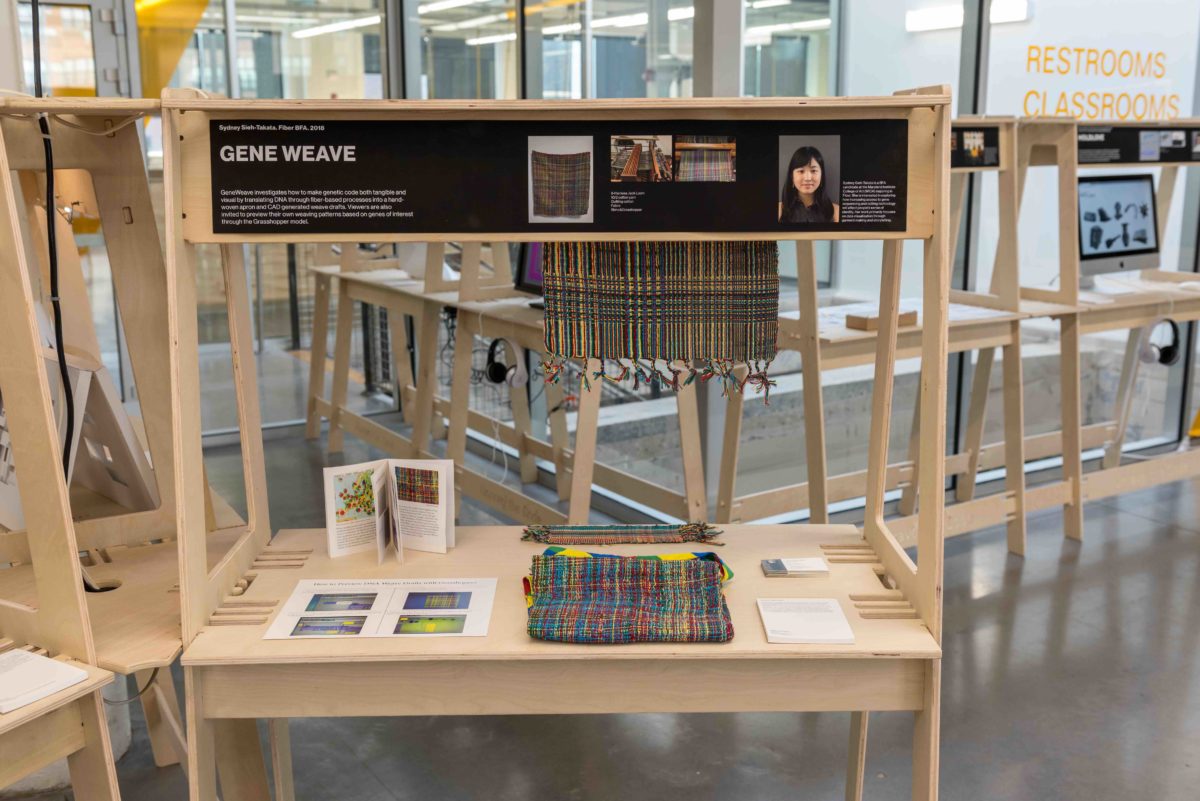In Open Works’ lobby, an exhibit from students at nearby MICA shows projects such as GeneWeave. Created by B.F.A. Fiber student Sydney Sieh-Takata, the project combines genetic code and traditional weaving. Elsewhere, Hold Love from Kilynne Higgins and Anais Perez offers audio on the meaning behind the objects that are valuable. Chase Body explored bots and facial recognition with The Sympathizer.
They were a few of the 17 products of Unravel the Code, a fall semester course at MICA that bridges traditional craft techniques and digital techniques. Conceived six years ago by Annet Couwenberg, the course offers a chance to create new products, as well as the learning theory behind craft. It draws from across majors at MICA, showing an interdisciplinary approach that the arts college has been encouraging.
As the art and tech worlds get closer together, the course looks to show the connection behind the two areas. It also gives students room to make something new.
“So much of what we’re teaching the students is within one discipline a lot of times…but what we really want to encourage is, how do you move laterally from one discipline into another,” said Ryan Hoover, who joined Couwenberg in teaching the class four years ago. “That’s one reason we fold traditional and digital craft together so you can understand things in a new way.”
Ryan Hoover, who joined Couwenberg four years ago, offered the example of weaving. “We look at that as an inherently binary process. You’re going over and under, up down, zero-1,” he said.
That brings an understanding to the level of how what’s made on a loom can work with a computer-based system.
“Weaving has always been digital, it’s always been algorithmic, it’s always been programming. These concepts pre-exist the technologies that we use today,” Hoover said.
As Couwenberg put it, “If you want to innovate and shift ideas, it needs to be based on the past.”
The idea is apparent in GeneWeave, where the connection between art and science is demonstrated in the form of an apron.
As far as the approach, the course is very much in line with present cycles of creating. Couwenberg and Hoover give students the space to create what interests them, but the course moves fast. The idea is to get a working project within the semester, on top of the workshops and reading that is required.
“You pick up what you need. Artists have a tendency to do that anyway,” Couwenberg said.
There is also a focus on collaboration. For one, students often work together on the projects. Couwenberg, who is frequently seeking to push forward wearable technology, also brings in instructors with backgrounds between art and tech such as MICA alum and chemist Margaret MacDonald, Paul Mirel of NASA and Alan Grover from the Baltimore Node.
“If a student becomes interested and committed to a project that is beyond what they can do, it forces them to connect with other people, to network, to learn from each other and it really gets that dynamic energy going,” Hoover said.
The course also offers the chance for further collaboration with students from the Netherlands. Students traveled to Willem de Kooning Academie in Rotterdam, the Netherlands, to collaborate with other students on facial recognition and machine learning. The students learn a lot and develop physical products in a short time period, this time in three days. They also attend Dutch Design Week, Design Academy Eindhoven and the wearable sensors lab at Eindhoven Technical University.
Along with cultural boundaries, the visit helps drive home how the Dutch view disciplines.
“We really emphasize that there is no difference between craft, art and design. There is a fluidity,” Couwenberg said, adding tech and engineering to that list.
When they return, the course projects went to the Open Works exhibit, which involves work on presentation of the products through bios and pitches, as well as displaying the work. It remains on view until Jan. 19.
But the connection to the course isn’t done there. Couwenberg said the class has become a community in itself, with many students finding opportunities as a result and returning to teach. Following the 2017 session, students are getting that experience right away with community-facing workshops
The workshops, held at Open Works, include:
- Processing Basics & How to use it with Arduino, taught by Dione Lee. Held Sunday, January 14, 12 – 4 pm.
- Motor Applications Workshop. Jihae Choe will provide instruction in different kinds of motors and how to control them with Arduino. It’s held Monday, January 15, from 6 – 9 p.m.
Join the conversation!
Find news, events, jobs and people who share your interests on Technical.ly's open community Slack

Baltimore daily roundup: Gen AI's software dev skills; UpSurge Tech Ecosystem Report; MD service year program

Baltimore daily roundup: Mayoral candidates talk tech and biz; a guide to greentech vocabulary; a Dutch delegation's visit

Baltimore daily roundup: An HBCU innovation champion's journey; Sen. Sanders visits Morgan State; Humane Ai review debate


